Are you a fan of walnuts? If so, you’ll definitely love pecans! Pecans are a delightful dry fruit that bears a striking resemblance to walnuts. They not only share a similar appearance but also offer a wide range of benefits that make them a wonderful addition to your diet.
Key Takeaways:
- Pecans are a tasty dry fruit that closely resemble walnuts in both appearance and culinary uses.
- Like walnuts, pecans are packed with beneficial nutrients and offer various health benefits.
- Incorporating pecans into your diet can provide you with a nourishing and delicious snack option.
- When it comes to dry fruits, pecans and walnuts are excellent choices due to their nutritional value and versatility.
- Give pecans a try, and discover a new flavor-packed and healthy snacking option!
Appearance and Culinary Uses
Pecans and walnuts are often mistaken for each other due to their similar appearance, but they have distinct differences. Walnuts have a light brown, round shell with a dense and ridged texture. On the other hand, pecans have a darker and more oblong shell that is harder to crack. When it comes to the edible portion, walnuts have a larger and convoluted shape, resembling a brain, while pecans are typically found in halved form, with a smaller and straighter appearance.
These differences in appearance also contribute to their culinary uses. Walnuts have a slightly bitter taste and are commonly used to add a crunchy texture in various dishes such as desserts, salads, granolas, and oatmeal. Pecans, on the other hand, have a sweeter taste and can be found in recipes like sweet potato casseroles, salads, pastries, and pecan-centric desserts.
Despite these differences, both pecans and walnuts can generally be swapped in most recipes, allowing you to experiment and enjoy the unique flavors and textures that each nut brings.
| Pecans | Walnuts |
|---|---|
| Dark, oblong shell | Light brown, round shell |
| Harder to crack | Dense and ridged shell |
| Sweeter taste | Slightly bitter taste |
| Common culinary uses: sweet potato casseroles, salads, pastries, pecan-centric desserts | Common culinary uses: desserts, salads, granolas, oatmeal |
Nutritional Value
Pecans and walnuts are both nutritious and offer similar health benefits. Let’s take a closer look at their nutritional profiles.
Pecan Nutrition Facts
Here are the nutritional facts for one ounce (28 grams) of pecans:
| Nutrient | Amount |
|---|---|
| Calories | 190 |
| Protein | 3g |
| Fat | 20g |
| Carbohydrates | 4g |
| Fiber | 3g |
| Calcium | 20mg |
| Iron | 0.7mg |
| Magnesium | 34mg |
| Phosphorus | 66mg |
| Potassium | 116mg |
| Zinc | 0.6mg |
| Vitamin B6 | 0.1mg |
| Vitamin E | 2.6mg |
| Vitamin K | 0.8mcg |
Walnut Nutrition Facts
Here are the nutritional facts for one ounce (28 grams) of walnuts:
| Nutrient | Amount |
|---|---|
| Calories | 200 |
| Protein | 5g |
| Fat | 18g |
| Carbohydrates | 4g |
| Fiber | 2g |
| Calcium | 28mg |
| Iron | 0.8mg |
| Magnesium | 45mg |
| Phosphorus | 93mg |
| Potassium | 125mg |
| Zinc | 0.9mg |
| Vitamin B6 | 0.2mg |
| Vitamin E | 0.7mg |
| Vitamin K | 0.8mcg |
While pecans and walnuts share many similarities in terms of nutritional content, there are some differences worth noting. Walnuts have slightly more protein and a more diverse micronutrient profile, while pecans contain more fiber and have a higher vitamin E content.
Health Benefits
Both pecans and walnuts offer a wide range of health benefits. Pecans are rich in antioxidants and unsaturated fats, making them a great addition to a healthy diet. These nutrients contribute to reduced inflammation and improved heart health. Pecans also contain fiber, vitamins A and B, and minerals that support bone health, digestion, and a strong immune system. Adding pecans to your meals can help lower the risk of chronic diseases such as cancer, stroke, Parkinson’s, and Alzheimer’s.
On the other hand, walnuts are packed with omega-3 fatty acids, which are essential for brain health. These healthy fats play a crucial role in reducing the risk of heart disease, lowering cholesterol levels, and improving cognitive function. Walnuts also have anti-inflammatory properties that can benefit overall wellness. Additionally, the high protein and fiber content in walnuts can aid in weight loss and management.
Both pecans and walnuts offer unique health advantages:
The antioxidants and unsaturated fats in pecans support heart health and reduce inflammation, while omega-3 fatty acids in walnuts promote brain health, lower the risk of heart disease, and offer anti-inflammatory properties.
Health Benefits Summary:
| Pecans | Walnuts |
|---|---|
| Reduced inflammation | Brain health |
| Improved heart health | Lowered risk of heart disease |
| Lower risk of chronic diseases | Anti-inflammatory properties |
| Bone health support | Weight loss and management |
| Digestive health | |
| Strong immune system |
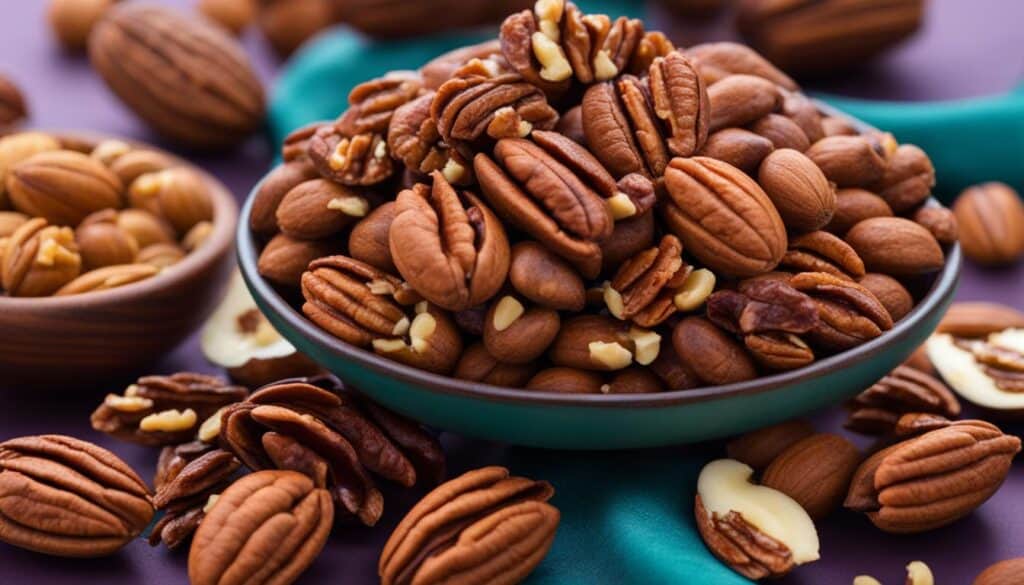
*Note: This image highlights the health benefits of pecans and walnuts, illustrating their contributions to heart health, brain health, and anti-inflammatory properties.
Culinary Uses of Pecans
Pecans are a versatile ingredient that can elevate your baking and cooking endeavors. Their sweet and nutty flavor makes them a perfect addition to a variety of sweet recipes, such as pecan pies, cookies, and cakes. When paired with other ingredients, pecans can create delectable treats that will satisfy any sweet tooth.
But pecans aren’t just limited to desserts. They can also be used in savory dishes to add a crunchy texture and a hint of rich flavor. Pecans can be sprinkled on top of salads, roasted vegetables, or added to chicken or fish dishes for an extra element of taste and texture.
Making Homemade Pecan Butter
If you’re looking for a unique and delicious spread, why not try making homemade pecan butter? Pecan butter is easy to make and provides a creamy and nutty alternative to traditional spreads. Simply blend toasted pecans in a food processor until smooth and creamy, and you’ll have a delightful spread that can be enjoyed on toast, pancakes, or used as an ingredient in various recipes.
Here’s a simple recipe to make your own pecan butter:
- Toasting the pecans: Spread pecans on a baking sheet and toast them in the oven at 325°F for 7-10 minutes until they become fragrant.
- Blending the pecans: Transfer the toasted pecans to a food processor and blend them until they reach a smooth and creamy consistency.
- Adding flavor (optional): You can customize your pecan butter by adding a pinch of salt, a drizzle of honey, or spices like cinnamon or vanilla extract.
- Storing the pecan butter: Transfer the pecan butter into a clean jar or airtight container and store it in the refrigerator for up to two weeks. Remember to stir the butter before each use.
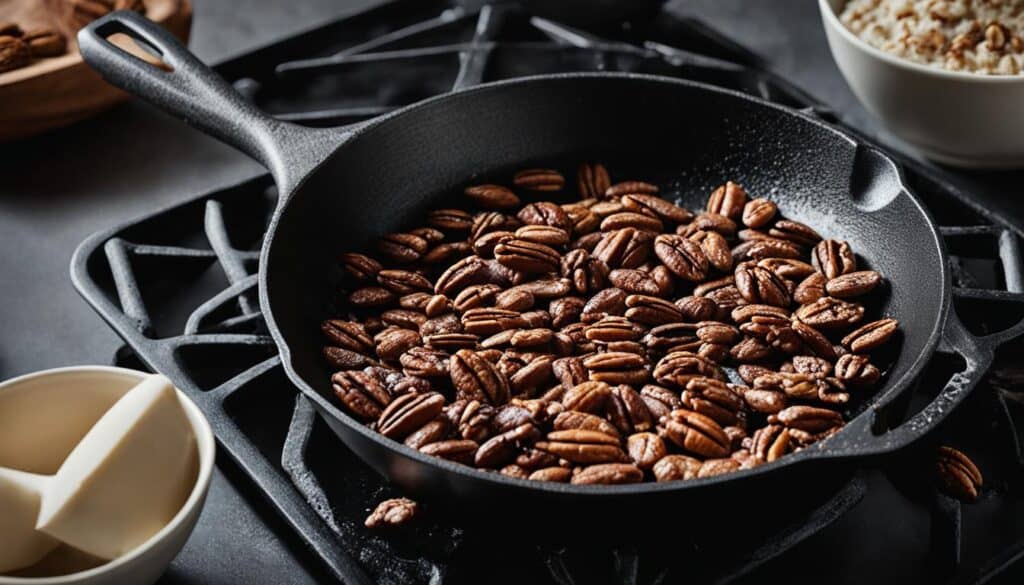
Toasting pecans before using them in your recipes can enhance their natural oils and deepen their flavor. Whether you’re baking pecan-infused treats or creating creamy pecan butter, taking this extra step of toasting will add a delightful nuttiness to your dishes.
So go ahead and explore the various culinary uses of pecans, from incorporating them into your favorite baked goods to making delicious pecan butter. The possibilities are endless when it comes to this versatile and flavorful nut.
Culinary Uses of Walnuts
Walnuts are a versatile ingredient that can enhance both sweet and savory dishes. Their earthy and nutty flavor adds depth to a wide range of recipes, making them a popular choice for bakers and chefs alike.
Walnuts in Baking: When it comes to baking, walnuts are a fantastic addition to cookies, muffins, and breads. Their crunchy texture and rich flavor complement a variety of baked goods, adding a delightful twist to traditional recipes. Whether sprinkled on top or mixed into the batter, walnuts bring a distinct nuttiness that will have you reaching for seconds.
Walnut Recipes: From walnut crusted chicken to walnut-stuffed mushrooms, there are countless savory recipes that incorporate the unique taste of walnuts. These versatile nuts add a delightful crunch to savory dishes, creating a delicious contrast of textures. Whether used as a topping or folded into a stuffing, walnuts can elevate your savory creations to new heights.
Walnut Butter: If you’re looking for a healthier alternative to traditional spreads, try making your own walnut butter. Simply crush or grind the walnuts until they form a smooth paste, and you’ll have a delicious and nutritious spread that can be enjoyed on toast, in sandwiches, or as a dip for fruits and vegetables.
Toasting Walnuts: Toasting walnuts can intensify their natural flavors and add a delightful crunch. Spread the walnuts evenly on a baking sheet and roast them in the oven at 325°F for a few minutes, or pan-toast them over medium heat until they become fragrant. The toasted walnuts can be used in both sweet and savory dishes, bringing an extra layer of depth and aroma to your creations.

Toasting walnuts enhances their flavor and crunch, making them even more irresistible in your favorite recipes.
Other Dry Fruits Similar to Walnut
While pecans are often compared to walnuts for their similarities, there are other dry fruits that have similar qualities to walnuts. Some alternatives include almonds, hazelnuts, and cashews, which are all packed with flavor and offer their own unique health benefits.
Almonds, a popular choice among nut enthusiasts, are a great source of vitamin E and calcium. They provide a rich and creamy texture, making them an excellent addition to both sweet and savory dishes.
Hazelnuts, known for their distinct flavor and crunchy texture, are rich in antioxidants and vitamin E. They add a delightful nuttiness to recipes and can be enjoyed on their own as a nutritious snack.
Cashews, often associated with creamy sauces and vegan dishes, are high in healthy fats and essential minerals. They offer a buttery and delicate taste that pairs well with a variety of flavors.
These dry fruits can be used as substitutes in recipes or enjoyed on their own as nutritious and tasty snacks. Whether you’re avoiding walnuts due to allergies or simply looking for a change, these alternatives can provide the same satisfying crunch and nutritional value.
Comparison of Dry Fruits:
| Dry Fruits | Nutritional Benefits |
|---|---|
| Almonds | Rich in vitamin E and calcium |
| Hazelnuts | High in antioxidants and vitamin E |
| Cashews | Good source of healthy fats and essential minerals |
Note: Nutritional values may slightly vary based on the brand and processing methods.
Try incorporating these walnut-like dry fruits into your recipes or enjoy them as satisfying and nutritious snacks. They can be a delightful alternative to walnuts, providing a wide range of flavors and health benefits.
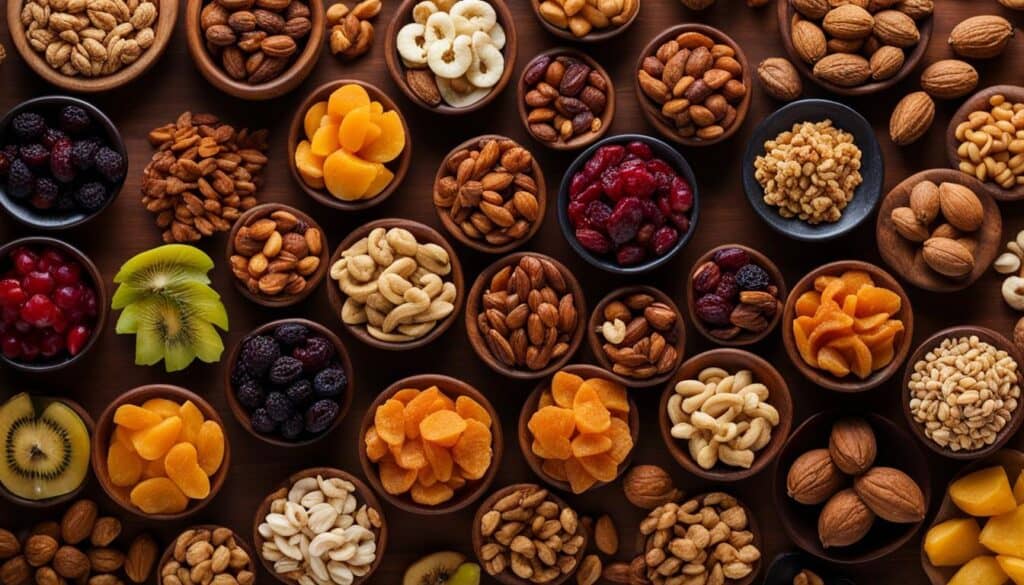
Choosing Healthy Snacks
When it comes to snacking, it’s essential to choose options that not only satisfy your cravings but also provide nutritional value. That’s where dry fruits like pecans and walnuts come in. These delicious treats are not only packed with flavor but also offer a range of health benefits.
Dry fruits such as pecans and walnuts are nutrient-dense, making them a fantastic choice for a healthy snack. They are rich in healthy fats, fiber, vitamins, and minerals, all of which contribute to a balanced diet. Incorporating these nutritious snacks into your daily routine can have a positive impact on your overall well-being.
One of the key benefits of dry fruits is their ability to provide sustained energy. The combination of healthy fats and fiber in pecans and walnuts helps keep you feeling full and satisfied for longer periods, making them an ideal snack for busy days or when you’re on the go.
Furthermore, dry fruits like pecans and walnuts can be beneficial for weight management. Their nutrient density and high fiber content can help you feel satiated while providing essential nutrients. By choosing these snacks over less nutritious options, you can maintain a healthy weight and support your overall diet goals.
Another advantage of incorporating dry fruits into your snacking routine is their numerous health benefits. Pecans, for example, are known for their heart-healthy properties. They contain monounsaturated fats, which can help lower cholesterol levels and reduce the risk of heart disease. Walnuts, on the other hand, are renowned for their brain-boosting properties. Rich in omega-3 fatty acids, walnuts can support cognitive function and improve overall brain health.
Choosing nutritious snacks like pecans and walnuts also allows you to indulge your sweet or savory cravings without compromising your health. Whether you prefer a sweet and crunchy snack or a savory addition to your salads or trail mixes, dry fruits offer a delicious and wholesome option.
So, the next time you reach for a snack, consider the benefits of choosing healthy options like pecans and walnuts. These nutrient-dense dry fruits can provide you with the energy and nutrition your body needs, all while satisfying your taste buds.
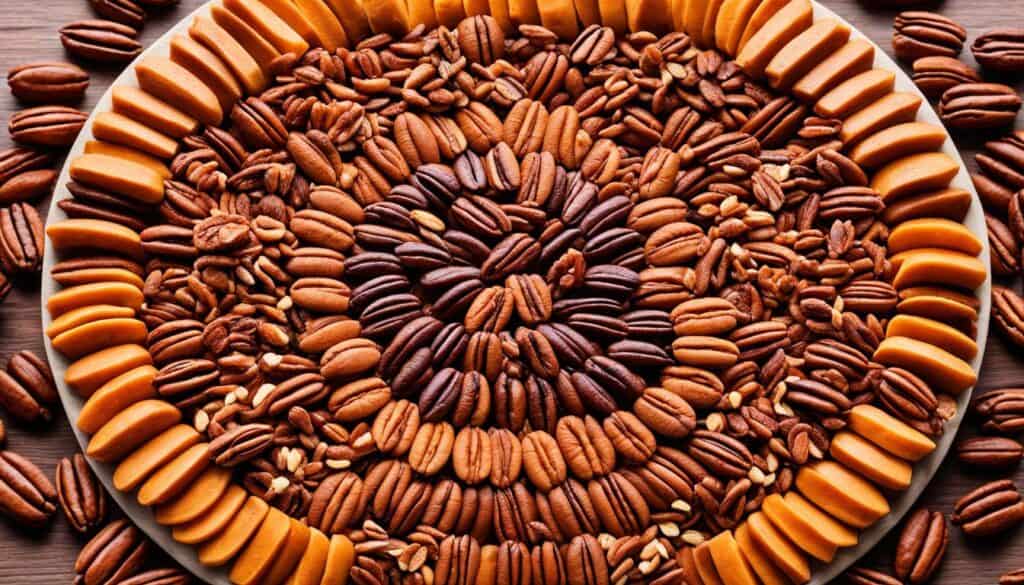
By incorporating pecans and walnuts into your diet, you can enjoy the many benefits of these delightful dry fruits. From their nutritional value to their versatility and flavor, they are the perfect choice for a healthy and tasty snack.
Conclusion
In conclusion, pecans and walnuts are both delicious and versatile dry fruits that offer a wide range of culinary uses and health benefits. Pecans, with their sweeter taste, are often compared to walnuts for their similar appearance and can be incorporated into various recipes, from salads to desserts. While there are slight differences in their nutritional content, both pecans and walnuts are packed with important minerals, vitamins, and healthy fats.
When it comes to choosing between pecans and walnuts, it ultimately depends on personal preference and the specific flavor profile desired in a recipe. However, both dry fruits can be enjoyed as a nutritious and tasty addition to a well-balanced diet. Whether you enjoy them as a quick snack, add them to your baked goods, or include them in savory dishes, pecans and walnuts are a great choice for their flavor and nutritional value.
Furthermore, if you’re looking for alternatives to walnuts, there are other dry fruits such as almonds, hazelnuts, and cashews that offer similar qualities and health benefits. These dry fruits can be used as substitutes in recipes or enjoyed as standalone snacks. Incorporating a variety of dry fruits into your diet can provide a diverse range of nutrients and contribute to overall health and well-being.
In summary, whether you prefer pecans, walnuts, or other dry fruits similar to walnuts, adding them to your diet can bring a delightful taste and numerous health benefits. So, next time you’re in the mood for a snack or planning a culinary creation, don’t forget to include these delicious dry fruits and enjoy their unique flavor and goodness.
FAQ
What are pecans?
Pecans are a type of dry fruit that are similar to walnuts in appearance and culinary uses.
What are the benefits of dry fruits?
Dry fruits, including pecans and walnuts, are nutrient-dense and offer numerous health benefits, such as improved heart health, reduced inflammation, and lower risk of chronic diseases.
What types of dry fruits are similar to walnuts?
Some dry fruits that are similar to walnuts include almonds, hazelnuts, and cashews.
What is the nutritional value of walnuts?
Walnuts contain essential minerals like calcium, iron, magnesium, phosphorus, potassium, and zinc, as well as vitamins B6, E, and K.
How can pecans and walnuts be incorporated into the diet?
Pecans and walnuts can be used in a variety of sweet and savory recipes, such as baked goods, salads, and spreads.
What are some dry fruit substitutes for walnuts?
Almonds, hazelnuts, and cashews are all dry fruit substitutes for walnuts, offering their own unique flavors and health benefits.
What should I consider when choosing healthy snacks?
When choosing healthy snacks, it is important to consider their nutritional value, including the presence of healthy fats, fiber, and essential vitamins and minerals.

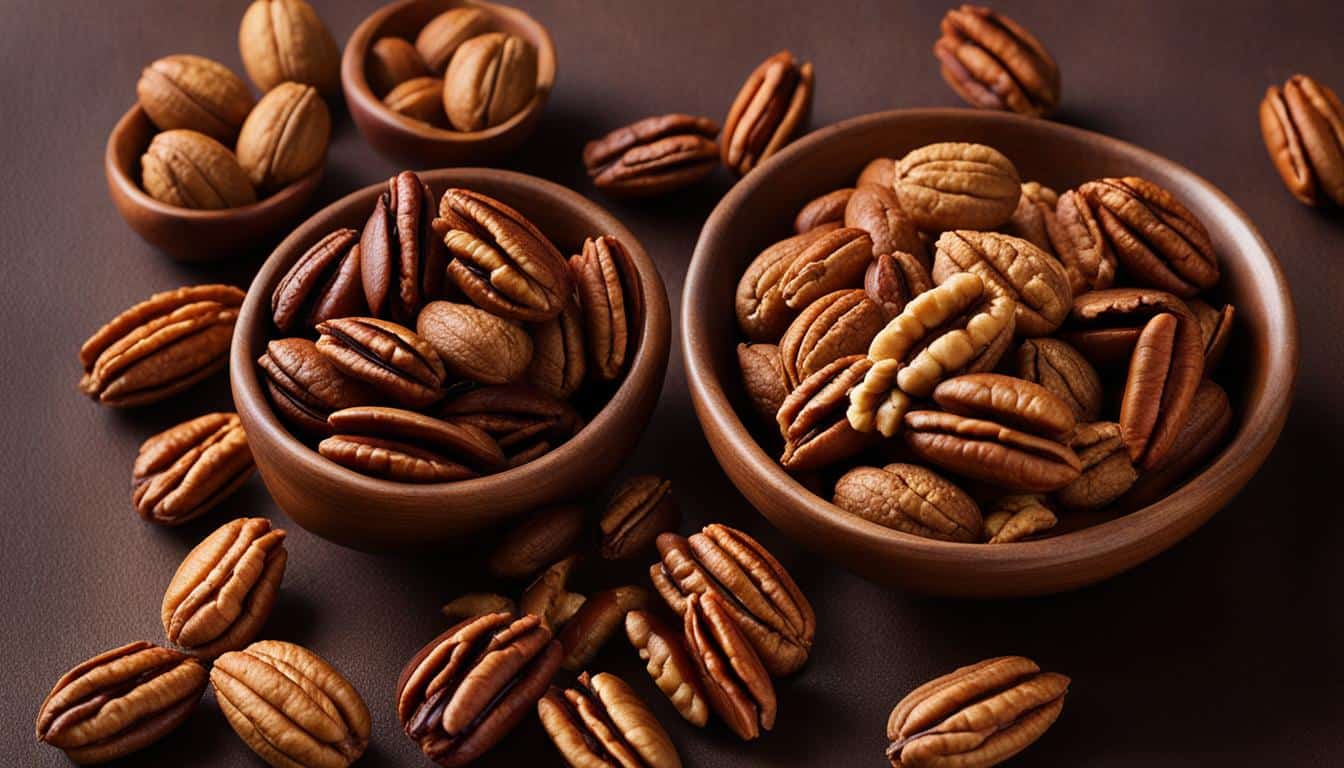



Leave a Reply